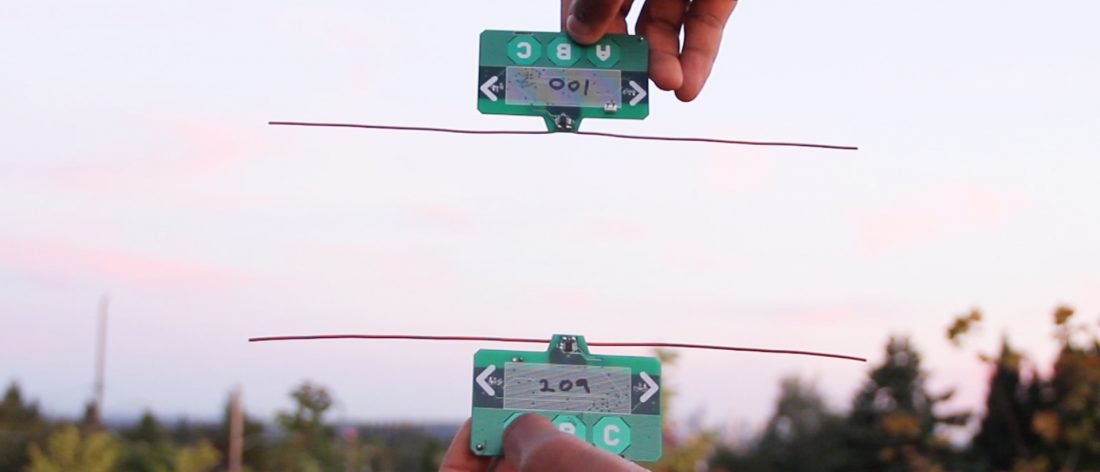The age of information has made its presence known since a decade worth of years now. It’s no longer a fight to innovate; it’s time to perfect the previous innovations. At this moment the biggest challenge we’re facing is that we’re running out of resources on the planet fairly quickly. The next couple of decades that the earth will go through will be rather tough once we start to feel the crunch due to the lack of resources. This includes the absence of fossil fuels and other conventional ways of powering our cities. It is observable that the environmental footprint of the current technology is still low as compared to the previous generation but it’s still there. The conflict now seems to have shifted towards trying to create devices which have a low carbon footprint, at the same time are compact in their size and uses less power more effectively.
Somehow to create a device with the exact same purpose, several students from the University of Washington were able to create a technology that seems to come straight out of the Sci-Fi world. These masterminds of technology have been igniting their startup for a while now and after receiving of a funding of $1 million from investors, they’re all ready to change the outlook of IoT (Internet of Things). This interestingly advanced technology developed by Jeeva Wireless with a team of dynamic 7 people, can help two devices to communicate with the using the non-conventional method of using the pre-existing ambient RF signals in the atmosphere and use them to both be used as the communication channel and at the same time use these RF signals to provide power to the devices which are using this technology. This means that the use of bulky and space consuming power sources will be reduced for the devices which aim to attain the smallest size and maximum effectiveness.
How does it work?
Since the usage of Ambient Backscattering seems a little Science fictional still, allow me to explain to you how this works. These devices harvest the power from thin air. They make use of all the existing ambient signals in the air and convert them into power while at the same time uses the same as a communication channel. Since you first want to know about these ambient signals, let’s talk about them.
These Ambient signals are basically the ambient Radio Frequency present in the atmosphere due to the regular presence of TV and/or cellular antennae in the environment. The Ambient Backscattering devices are then used to reflect the present ambient RF signals in the atmosphere of urban areas fairly easily, which is known as backscattering and thus achieves communication.

The prototype devices that were using this technology pick up these RF signals and reflect these back and forth between the devices. Similar devices with the same antennae pick up these reflected signals, decode them, and reply with a response. The communication achieved by the devices happens without the use of an external power source.
An example
Two devices A and B exist in a vicinity of a TV tower that is constantly providing RF frequencies in the area. These frequencies will act as a communication medium which inherently removes the need for an external RFID reader which has a dedicated power.
When A wants to send information to B, the device will somehow backscatter these ambient signals to convey bits in the packet which can be used to indicate either 1 or 0. This happens by switching an antenna from a reflecting to non-reflecting state. This backscattered signal will be picked up by B as an additional path from TV tower to B. The same signal will, however, be picked by other devices searching for signals in the same frequency too.

A TV tower is a perfect tool which empowers the process of backscattering. This happens because the signals which are sent out by the TV tower are extensively transmitted all the time 24/7 and can thus be used to as a source for power and signal across the day and consequently can be used to achieve communication.
In action
While all of this seems to look great on papers, nothing would matter unless there was a practical device built that worked on the similar principle. These credit card sized devices had a power harvester for TV signals. This power harvester is also used to communicate. They make use of the UHF TV signals that exist in a 50MHz wide frequency band, running on 539MHzs. To confirm the successful communication, the devices also have a low-power LED which flashes after every successful packet transmission. It is important to know that these devices were not connected to any power source, thus the flashing of the LED indicates that some power was transferred to these devices.
What makes Ambient Backscattering great?
The ambient backscattering technology is an asset to the world and the same is relayed from the following three reasons which make it great:
- Since the medium is already set up by the TV towers and the existing RF signals can be used for the transmission, the need of constructing extra infrastructures is negated.
- The close to nothing environment footprint that it has poses no threat to the environment as no additional energy consumption occurs.
- The direct device to device communication is an added benefit too.
The applications
Ambient Backscattering technology has a wide range of applications. With its current capabilities, the technology can effectively be applied to the following areas.
They can be used to effectively transfer the money from a bus pass to any card anywhere and at any time. Once a user swipes the touch sensor next to a card which needs the money, the stored balance can directly be transmitted to the microcontroller inside. The flashing LED can confirm the transaction too.
It can also be efficaciously used in grocery stores. The item tag with the Ambient scattering device can let the store owner know if the item is placed on the wrong shelf. A flashing LED can help with that.
In future, the use of this technology can help to keep the structures safe. Just by placing this device in a bridge with sensors connected to it can tell us about the hairline cracks that have formed in the bridge. Creating wearable devices that can communicate over long range with minimum to none battery usage is another application that would change the way we communicate with each other.
Thus with each passing day along with the advancement of technology, we keep walking further towards creating technology which reduces the carbon footprint of other devices too. The door to portable and lighter yet efficient technology has been opened. Negating the use of batteries on these tiny devices can make them even more efficient in fulfilling their purpose. Isn’t that what innovation should be?






